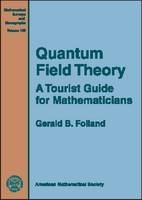
Quantum Field Theory
A Tourist Guide for Mathematicians
Seiten
2008
American Mathematical Society (Verlag)
978-0-8218-4705-3 (ISBN)
American Mathematical Society (Verlag)
978-0-8218-4705-3 (ISBN)
- Titel erscheint in neuer Auflage
- Artikel merken
Aims to present the elements of quantum field theory, with the goal of understanding the behavior of elementary particles rather than building formal mathematical structures. This book presents the functional integral approach and the elements of gauge field theory, including the Salam-Weinberg model of electromagnetic and weak interactions.
Quantum field theory has been a great success for physics, but it is difficult for mathematicians to learn because it is mathematically incomplete. Folland, who is a mathematician, has spent considerable time digesting the physical theory and sorting out the mathematical issues in it. Fortunately for mathematicians, Folland is a gifted expositor. The purpose of this book is to present the elements of quantum field theory, with the goal of understanding the behavior of elementary particles rather than building formal mathematical structures, in a form that will be comprehensible to mathematicians. Rigorous definitions and arguments are presented as far as they are available, but the text proceeds on a more informal level when necessary, with due care in identifying the difficulties. The book begins with a review of classical physics and quantum mechanics, then proceeds through the construction of free quantum fields to the perturbation-theoretic development of interacting field theory and renormalization theory, with emphasis on quantum electrodynamics.The final two chapters present the functional integral approach and the elements of gauge field theory, including the Salam-Weinberg model of electromagnetic and weak interactions.
Quantum field theory has been a great success for physics, but it is difficult for mathematicians to learn because it is mathematically incomplete. Folland, who is a mathematician, has spent considerable time digesting the physical theory and sorting out the mathematical issues in it. Fortunately for mathematicians, Folland is a gifted expositor. The purpose of this book is to present the elements of quantum field theory, with the goal of understanding the behavior of elementary particles rather than building formal mathematical structures, in a form that will be comprehensible to mathematicians. Rigorous definitions and arguments are presented as far as they are available, but the text proceeds on a more informal level when necessary, with due care in identifying the difficulties. The book begins with a review of classical physics and quantum mechanics, then proceeds through the construction of free quantum fields to the perturbation-theoretic development of interacting field theory and renormalization theory, with emphasis on quantum electrodynamics.The final two chapters present the functional integral approach and the elements of gauge field theory, including the Salam-Weinberg model of electromagnetic and weak interactions.
Prologue Review of pre-quantum physics Basic quantum mechanics Relativistic quantum mechanics Free quantum fields Quantum fields with interactions Renormalization Functional integrals Gauge field theories Bibliography Index.
| Erscheint lt. Verlag | 30.11.2008 |
|---|---|
| Reihe/Serie | Mathematical Surveys and Monographs |
| Zusatzinfo | Illustrations |
| Verlagsort | Providence |
| Sprache | englisch |
| Themenwelt | Mathematik / Informatik ► Mathematik ► Angewandte Mathematik |
| Naturwissenschaften ► Physik / Astronomie ► Quantenphysik | |
| ISBN-10 | 0-8218-4705-8 / 0821847058 |
| ISBN-13 | 978-0-8218-4705-3 / 9780821847053 |
| Zustand | Neuware |
| Informationen gemäß Produktsicherheitsverordnung (GPSR) | |
| Haben Sie eine Frage zum Produkt? |
Mehr entdecken
aus dem Bereich
aus dem Bereich
Buch | Softcover (2024)
Springer Vieweg (Verlag)
37,99 €
Buch | Softcover (2024)
Springer Vieweg (Verlag)
44,99 €
für Ingenieure und Naturwissenschaftler
Buch | Softcover (2024)
Springer Vieweg (Verlag)
34,99 €


